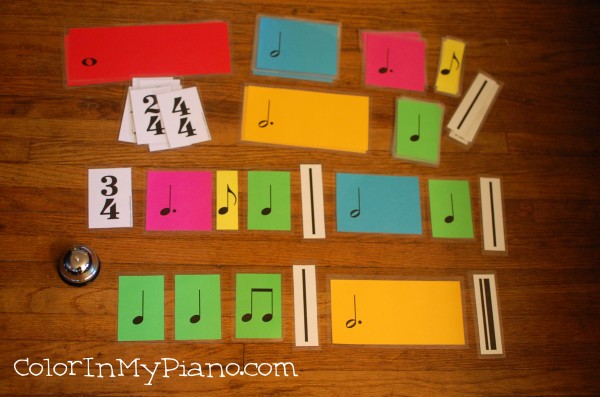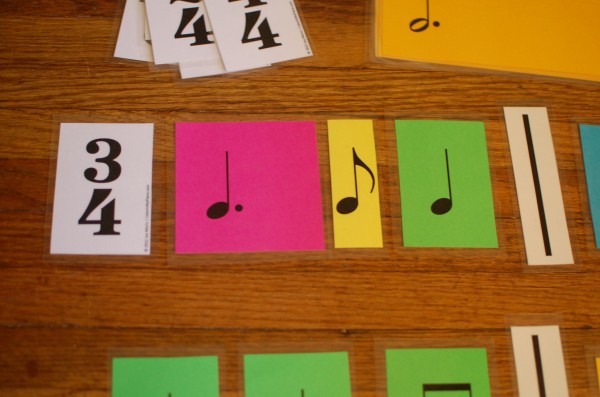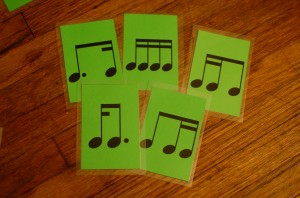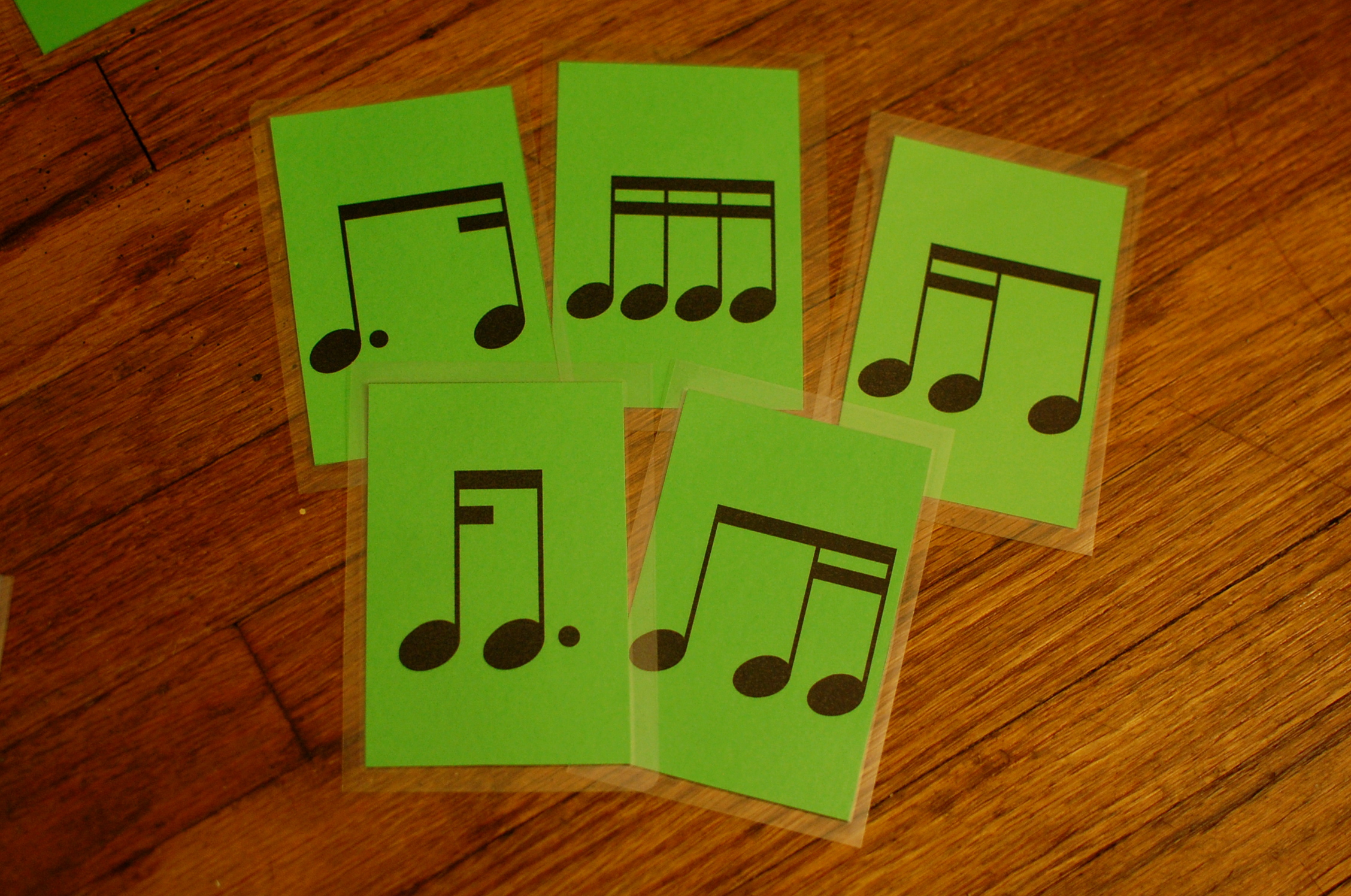Here they are…the rhythm value cards I mentioned in my post yesterday!

My favorite part about these cards is that their sizes are appropriate to show the number of beats each kind of note receives.

I printed my cards on colored cardstock so they are color-coded: green = 1 beat, pink = 1.5 beats, blue = 2 beats, orange = three beats, red = four beats, and yellow = 1/2 beat. I printed the barlines and time signatures on white cardstock. I printed and cut enough cards for two complete sets, since I wanted to play a game with two teams at my group lesson. I also laminated all the cards — which was VERY time consuming, but worth it because I plan to use these a lot in future years!
 The pdf contains many advanced rhythms, including sixteenth notes, dotted-eighth sixteenths, eighth note with two sixteenths, etc. There’s even eighth note triplets and quarter note triplets. I recommend giving students only the cards they’ll need for the activity you have planned. I keep the advanced cards in a separate zipper bag from the basic rhythms to make things easier.
The pdf contains many advanced rhythms, including sixteenth notes, dotted-eighth sixteenths, eighth note with two sixteenths, etc. There’s even eighth note triplets and quarter note triplets. I recommend giving students only the cards they’ll need for the activity you have planned. I keep the advanced cards in a separate zipper bag from the basic rhythms to make things easier.
These cards have many uses, but here are two quick ideas to get you thinking:
- The team-based rhythm dictation game I described in this post. I’ve done this activity with my homeschool music class too, but with no teams or points. The students simply work together to notate the rhythms they hear.
- In the private lesson, have students create their own rhythms using the cards and then clap/tap them to see how they sound. When a student is learning a new rhythm, sometimes the best thing to do is get them away from the piece and focus completely on rhythm!
To download this free pdf, visit the Printables > Games page and scroll down to the R’s for “Rhythm Value Cards for Dictation and More.”
 Rhythm Value Cards (1.9 MiB, 30,275 hits)
Rhythm Value Cards (1.9 MiB, 30,275 hits)
Enjoy, and please let me know what creative ways you find to use these cards!



Joy, I absolutely love your blog! I am currently a piano performance major and have been trying to build up my studio and I constantly research new and creative ideas to become a better teacher and I refer to your blog by far the most! I want you to know that I think you are amazing. I love feeling connected to others in the piano world! So thank you for having this wonderful place to exchange ideas and for being an inspiration to me!
Lauren Nelson
Hi Lauren! Thanks so much for the kind words, and for the encouragement to keep Color In My Piano going! I love feeling connected to other piano teachers too, so I hope you’ll stay in touch. Best wishes in your teaching!
Hi Joy! I love these cards…. I was wondering what computer program you use to create your worksheets? I want to start making my own, but I’m not sure what program would work best for this sort of thing.
I just use Microsoft Word and a music font. I hope to do a blog post about this process sometime soon… 🙂
I have been using a similar idea with my students as well and was even putting together my own blog post about it! What’s that saying about great minds? 😉
I love how tangible it makes the concept of time and rhythm for those who learn better that way.
Thanks so much for sharing your wonderful ideas! I’m trying to print the rhythm value cards and everything was great unitl page 4. I have bold bar lines on top of the dotted half notes. Did anyone else get these? Any clue what I’m doing wrong? Thanks, Miriam
How strange! Is there perhaps another computer you could try printing from? I have no idea what could be causing this. Let me know if there’s anything else I can do to help.
Hi Joy,
Thanks so much for your blog and for these great cards. I love how much thought you’ve put into the colour coding and sizing for these cards – they’re brilliant!
I was wondering whether you could please create some quavers (eighth notes) grouped in threes to equal a dotted crotchet (dotted quarter note) in compound time? These could then be used to help students really understand the difference between simple and compound time.
Or failing that, please share with us which font you used to create your sheets (and where you get it from), and any other tips we might need, so that I can create my own extras.
Thanks so much
Thanks for catching that, Bee! I’ve added a page for three beamed eighths. The music font I used for this pdf is called MusiSync. You can read more about using music fonts at this post: https://colorinmypiano.flywheelsites.com/2012/04/23/music-fonts/
Thanks Joy! I read your post on the music fonts and was going to attempt to make my own, but very grateful that you have done it for me! Thanks again!
Joy, Is it possible to make cards for the corresponding rests? (i.e. quarter rest, half rest, whole rest…)
I am enjoying your website.
Thank you for sharing.
My mistake. I found them…..
Glad you found them!
I just found out your blog today, and feel so excited to read all of them. Thank you for sharing your ideas for everything. How do you laminate all those flash cards? They are fabulous.
Hi Vidollia! I found a laminator at Aldi for very cheap (https://colorinmypiano.flywheelsites.com/2012/03/23/my-new-laminator/). You can find laminators on Amazon or at Costco or Wal-mart for about $25-30. I buy these 3 mil laminating pouches from Universal on Amazon, and they work great!
on Amazon, and they work great!
I’ve been looking for an excuse to make these just cause I’m a piano geek. ;o) I’ve been teaching music and rhythm to 5 years old. I used the basic notes with my kindergarten class. Well, they loved them. The director loved them even more because the school is Montessori and they love anything visual. Thanks for making these and my life easier! :o)
Glad to hear they were useful!
Hi there Joy!
I LOVE these.
Would you consider making single 16th notes and 16th rests, too?
What about a “dot” card.
Thank you!!
Hi Glenda!
It would be challenging (but not impossible) to make single sixteenth note cards that are thin enough without having to altering the appearance of the sixteenth note. I think I would probably have to create an entirely new set designed specially around sixteenth notes. It’s not something I have time to do right now, but I may consider it for the future!